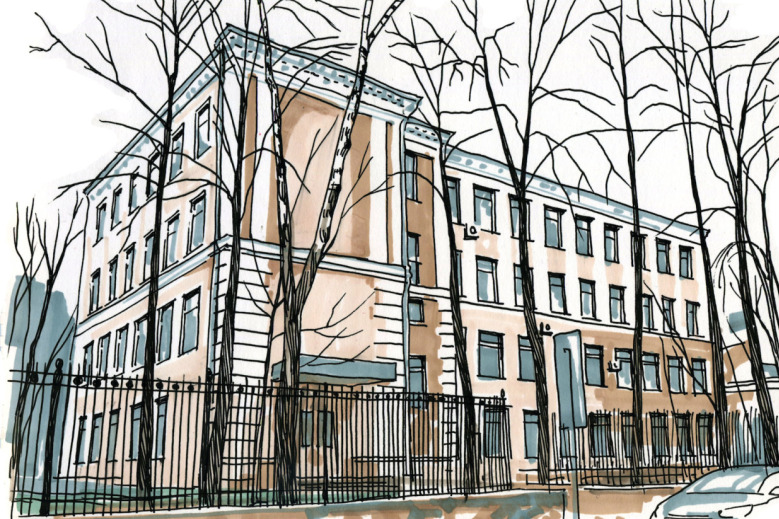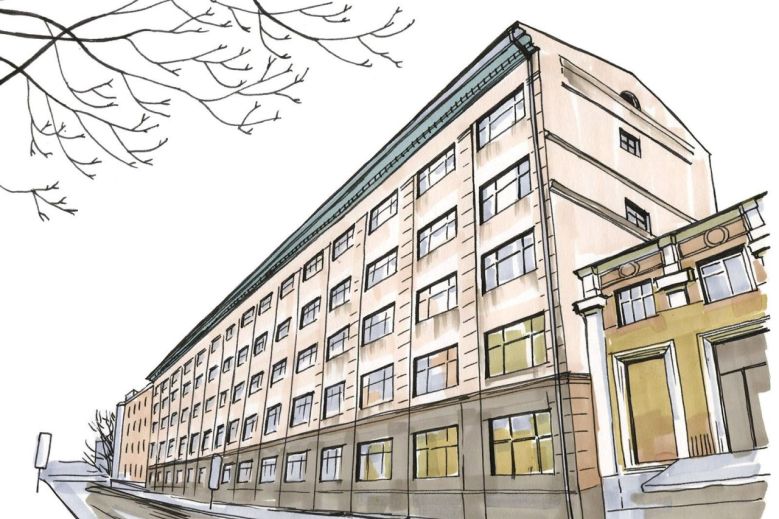The project ‘HSE. Cornerstone’ covers the history of the buildings the university occupies today
10th line of Vasilyevsky Island, Building 3/30
The building that used to house St. Petersburg's Patriotic Institute has held its status as an educational establishment for more than 200 years. It was founded as a school for the daughters of heroes who fought in the Patriotic War of 1812. In the 1830s, Nikolai Vasilievich Gogol taught history at the Institute, and after the October Revolution, students learned the fundamentals of physics and mechanics.

4 Maly Gnezdnikovsky Pereulok
The series of descriptions of historic buildings in Moscow owned by HSE concludes with this account of what was once School Number 135 in Maly Gnezdnikovsky Pereulok. This was considered an exemplary institution, and the finest teachers in the region taught there. Of course, the schoolchildren’s behavior was not always exemplary – and one incident even forced the Headmaster to resign.
Petrovka 12, Building 1
During the years of Lenin's New Economic Policy (NEP), this building housed Moscow's most fashionable institution, The Centre for the Development of the New Soviet Attire. The vast window displays were populated by mannequins in dresses, and fashion shows drew people from all segments of society: members of the Party elite, 'NEP-men' and their wives, and ‘heroes of industry’.
40 Myasnitskaya
The lives of postal workers in the 19th century were hard, as were their duties. They didn’t get paid enough to live, and they didn’t get any weekends or holidays, or even lunch breaks. Why is this relevant to HSE? Because this building used to belong to the postal service.
Milyutinsky Pereulok, 13, Building 1
The guesthouse with shops on the corner of Sretensky Pereulok and Milyutinsky Pereulok was built in 1900 by the architect Vladimir Sherwood. In Soviet times, the building housed a medical clinic for the district, which was soon replaced by an Intourist office. This organization had a large fleet of tourist buses, its own staff of guides and interpreters, and a chain of hotels. During the Moscow Olympics in 1980, Intourist was the main organization servicing foreign visitors. Intourist in fact received millions of visitors during the Soviet era.
Izmailovo Complex
For several hundred years Izmailovo Manor belonged to the imperial court. Russian tsars and their attendants hunted in the surrounding groves, and the area received the official status of the Moscow region after the revolution. Eventually factories and workers' settlements would be erected in place of the area’s trees and swamps. One of these factories was not like the others; it produced not machines or equipment, but answers to a number of questions.
17 Malaya Ordynka
In the 1950s, a golden candlestick was found in the ventilation system in one of the rooms of this building – a reminder of the fact that it was initially a jewellery factory. During the Soviet era, the building housed a leather and footwear training school, dormitory and a continuing education institute for engineering and technical personnel.
12/4 Malaya Pionerskaya
Building No. 12 on Malaya Pionerskaya Ulitsa has a complicated history. Residents of neighbourhoods and even some university staff members believe that a women's prison once stood here. This is not true. Before the revolution, it was the Olovyanishnikov merchants’ factory, which produced expensive church vessels. In the 1920s, the Geodesy Optical and Mechanical Plant had already found a new home at this location. This is where the first Soviet model camera Leica was manufactured, which was to become the best in the world, although that never came to be.
18 Myasnitskaya
This house was rebuilt first by merchant Old Believers, who owned the largest optical workshop in Russia, then by former peasants who made their fortunes selling houseware. The original appearance of the building changed with time: during the war, the front lost a part of its sculptural decorations and recently an attic floor was added which broke with the initial architectural concept. Even so, number 18 is one of the most remarkable buildings on Myasnitskaya Ulitsa.
4 Slavyanskaya Square
The area where 4 Slavyanskaya Square is situated has had several names, the oldest of which is Kulishki. Though the Russian phrase for ‘the boonies’ is similar to Kulishki – and actually quite fitting – the two words are not connected. According to legend, demons used to roam the area, moaning around at night and sometimes even attacking older women. The building itself at 4 Slavyanskaya Square was built by the incredibly popular Russian architect Nikolay Zherikhov, who was in high demand at the time. Zherikhov was a recognized expert in Art Nouveau and the mastermind behind the extravagant commercial apartment buildings on the central streets of Moscow.
20 Myasnitskaya
The main wing of the Higher School of Economics occupies a huge territory between Myasnitskaya Ulitsa and Krivoklenny Pereulok. Inside, chambers from the early 18th century have been preserved, which at one time belonged to Prince Koltsov-Mosalsk, a descendent of Rurik. Later, the home was owned for a long time by the family of the wealthy Armenian merchant Ananyan. Later, in the the 1890s, part of the reconstructed building on Myasnitskaya was occupied by the offices of Alexander Bari, where the famous engineer Vladimir Shukhov worked.
The Shabolovka Buildings
The Shabolovka complex was built in the first part of the 19th century as a silk factory. Its owner was Petr Goujon, a frenchman who ate the local pigeons and flogged his female workers for their misdemeanours. In Soviet days the building acquired a statue of Dzerzhinsky and the nickname ‘Shpul’ka’ (bobbin).
The Khitrovka Buildings
Time and neglect have taken their toll on what was once a beautiful estate at Khitrovka. The architectural finery is lost along with a third of its territory. All that is left are memories of a rich and colourful history. The poet Fyodor Tyutchev spent his childhood here and later Mayakovsky and Erenburg were inmates in a prison on the site. Sofia Kuvshinnikova - the prototype for the heroine of Chekhov’s story The Grasshopper lived here with her husband. This article in the series on the history behind HSE looks at the complex on Khitrovka.
24 Myasnitskaya
The former guesthouse of the Stroganov Academy is hardly visible from Myasnitskaya Ulitsa, although it deserves a close glance. This place once held the enormous estate of Baron Stroganov, a confidant of Empress Elizabeth. Nearly a hundred years later, his distant relative founded the first free drawing school, which later became the famous Stroganov School.

3 Bolshoy Tryokhsvyatitelsky Pereulok
The main story about this place begins not in the distant time when it was owned by merchants (although it certainly was) but in the 1930s when the construction of a new institute began. The name of the lane itself changed from Bolshoy Tryokhsvyatitelsky (after the church of the three holy bishops - Tryoksvyatiteli na Kulishakh - nearby) to Bolshoy Vuzovski.

8 Pokrovsky Boulevard
Building 8 on Pokrovsky Boulevard at various times has been a famous girl’s gymnasium, the apartment of the animalist painter Stepanov, and the editorial offices of the Great Soviet Encyclopedia.